
The red lionfish is a venomous coral reef fish in the family Scorpaenidae, order Scorpaeniformes. It is mainly native to the Indo-Pacific region, but has become an invasive species in the Caribbean Sea, as well as along the East Coast of the United States and East Mediterranean and also found in Brazil at Fernando de Noronha.

Carcinus maenas is a common littoral crab. It is known by different names around the world. In the British Isles, it is generally referred to as the shore crab, or green shore crab. In North America and South Africa, it bears the name European green crab.

The lesser frigatebird is a seabird of the frigatebird family Fregatidae. At around 75 cm (30 in) in length, it is the smallest species of frigatebird. It occurs over tropical and subtropical waters across the Indian and Pacific Oceans as well as off the Atlantic coast of Brazil.

The banded bellowsfish, banded yellowfish, banded snipefish, or bluebanded bellowsfish, is a species of fish of the family Macroramphosidae, found in southern oceans at depths of 35 to 1,000 m. Its length is up to 30 cm (12 in).

The sea toads and coffinfishes are a family, the Chaunacidae, of deep-sea ray-finned fishes belonging to the monotypic suborder Chaunacoidei within the order Lophiiformes, the anglerfishes. These are bottom-dwelling fishes found on the continental slopes of the Atlantic, Indian, and Pacific Oceans, at depths to at least 2,460 m (8,070 ft). There have also been findings of deep-sea anglerfishes off the coasts of Australia and New Caledonia. Other findings suggest some genera of Chaunacidae are found near volcanic slopes encrusted with manganese. Of the two genera in the family, Chaunacops are typically found at deeper depths than Chaunax, but with considerable overlap between the two genera.

Phyllorhiza punctata is a species of jellyfish, also known as the floating bell, Australian spotted jellyfish, brown jellyfish or the white-spotted jellyfish. It is native to the western Pacific from Australia to Japan, but has been introduced widely elsewhere. It feeds primarily on zooplankton. P. punctata generally can reach up to 50 centimetres (20 in) in bell diameter, but in October 2007, one 74 cm (29 in) wide, perhaps the largest ever recorded, was found on Sunset Beach, North Carolina.

The Lessepsian migration is the migration of marine species along the Suez Canal, usually from the Red Sea to the Mediterranean Sea, and more rarely in the opposite direction. When the canal was completed in 1869, fish, crustaceans, mollusks, and other marine animals and plants were exposed to an artificial passage between the two naturally separate bodies of water, and cross-contamination was made possible between formerly isolated ecosystems. The phenomenon is still occurring today. It is named after Ferdinand de Lesseps, the French diplomat in charge of the canal's construction.

Asterias amurensis, also known as the Northern Pacific seastar and Japanese common starfish, is a seastar found in shallow seas and estuaries, native to the coasts of northern China, Korea, far eastern Russia, Japan, Alaska, the Aleutian Islands and British Columbia in Canada. Two forms are recognised: the nominate and formarobusta from the Strait of Tartary. It mostly preys on large bivalve molluscs, and it is mostly preyed on by other species of starfish. Population booms in Japan can affect the harvest of mariculture operations and are costly to combat.

Hemigrapsus sanguineus, the Japanese shore crab or Asian shore crab, is a species of crab from East Asia. It has been introduced to several other regions, and is now an invasive species in North America and Europe. It was introduced to these regions by ships from Asia emptying their ballast tanks in coastal waters.

Panulirus versicolor is a species of spiny lobster that lives in tropical reefs in the Indo-Pacific. Other names include painted lobster, common rock lobster, bamboo lobster, blue lobster, and blue spiny lobster. P. versicolor is one of the three most common varieties of spiny lobster in Sri Lanka, alongside Panulirus homarus and Panulirus ornatus.
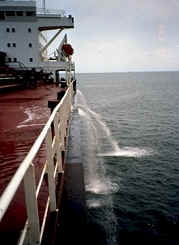
Ballast water discharges by ships can have a negative impact on the marine environment. The discharge of ballast water and sediments by ships is governed globally under the Ballast Water Management Convention, since its entry into force in September 2017. It is also controlled through national regulations, which may be separate from the Convention, such as in the United States.

Organisms targeted by NISA are categorized as aquatic nuisance species, including in particular zebra mussels and Eurasian ruffe. To extend upon NANPCA, NISA authorizes regulation of ballast water, a key factor in the spread of aquatic invasive species; funding for prevention and control research; regional involvement with the Aquatic Nuisance Species Task Force; and education and technical assistance programs to promote compliance with the new regulations. NISA also includes specific actions for certain geographical locations, such as the Great Lakes, Chesapeake Bay, the Gulf of Mexico, and San Francisco Bay.
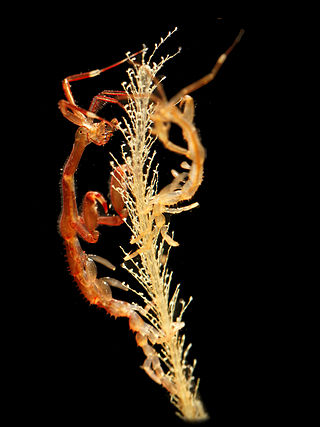
Caprella mutica, commonly known as the Japanese skeleton shrimp, is a species of skeleton shrimp. They are relatively large caprellids, reaching a maximum length of 50 mm (2.0 in). They are sexually dimorphic, with the males usually being much larger than the females. They are characterized by their "hairy" first and second thoracic segments and the rows of spines on their bodies. Body color ranges from green to red to blue, depending on the environment. They are omnivorous highly adaptable opportunistic feeders. In turn, they provide a valuable food source for fish, crabs, and other larger predators. They are usually found in dense colonies attached to submerged man-made structures, floating seaweed, and other organisms.

Pterois is a genus of venomous marine fish, commonly known as lionfish, native to the Indo-Pacific. It is characterized by conspicuous warning coloration with red or black bands, and ostentatious dorsal fins tipped with venomous spines. Pterois radiata, Pterois volitans, and Pterois miles are the most commonly studied species in the genus. Pterois species are popular aquarium fish. P. volitans and P. miles are recent and significant invasive species in the west Atlantic, Caribbean Sea and Mediterranean Sea.
Americamysis almyra is a shrimp-like crustacean in the order Mysida, the opossum shrimps. It is native to estuarine waters in the western Atlantic Ocean and Gulf of Mexico. It is often referred to in the literature as Mysidopsis almyra.
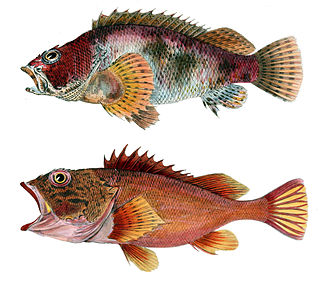
Sebastiscus marmoratus, the sea ruffe, false kelpfish or dusky stingfish, is a species of marine ray-finned fish belonging to the subfamily Sebastinae, the rockfishes, part of the family Scorpaenidae. It is found in the Western Pacific from southern Japan to the Philippines. It has also been sighted twice in Australia.

The Amazon Reef, or Amazonian Reef, is an extensive coral and sponge reef system, located in the Atlantic Ocean off the coast of French Guiana and northern Brazil. It is one of the largest known reef systems in the world, with scientists estimating its length at over 1,000 kilometres, and its area as over 9,300 km2 (3,600 sq mi). Publication of its discovery was released in April 2016, following an oceanographic study of the region in 2012. Evidence of a large structure near the delta of the Amazon River dated from as early as the 1950s.
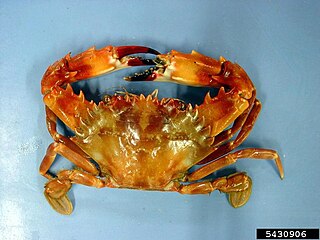
Charybdis hellerii, the Indo-Pacific swimming crab or spiny hands is a species of crab from the swimming crab family, the Portunidae. Its native range covers the Indian and Pacific Oceans but it has been introduced to the western Atlantic and has invaded the Mediterranean. It is a commercially exploited species in south-east Asia.
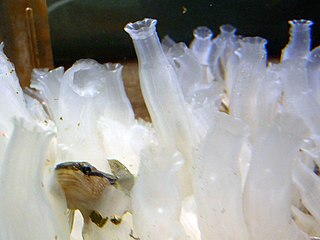
Ciona robusta is a species of marine invertebrate in the genus Ciona of the family Cionidae. The holotype was collected on the northeastern coast of Honshu Island, Japan. Populations of Ciona intestinalis known as Ciona intestinalis type A found in the Mediterranean Sea, the Pacific Ocean, east coast of North America, and the Atlantic coasts of South Africa have been shown to be Ciona robusta.
The dispersal of invasive species by ballast water refers to the unintentional introduction of invasive species to new habitats via the ballast water carried by commercial shipping vessels. Ballast water spreads an estimated 7000 living species to new habitats across the globe. These species can affect the ecological balance of their new regions by outcompeting native species or otherwise impacting native ecosystems.


















